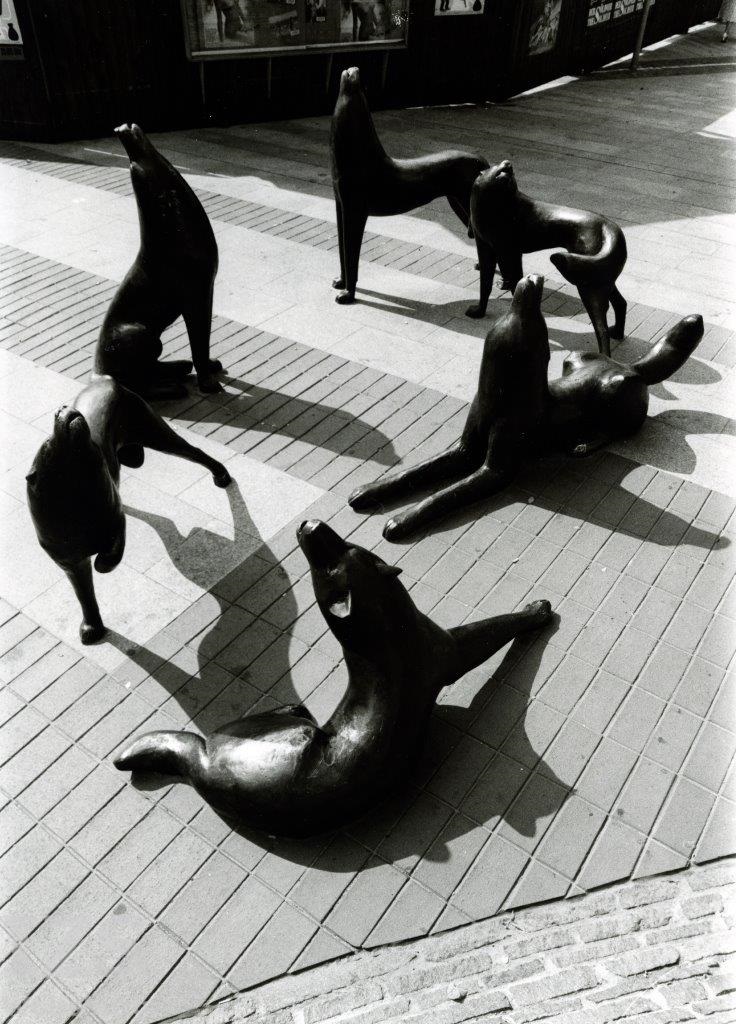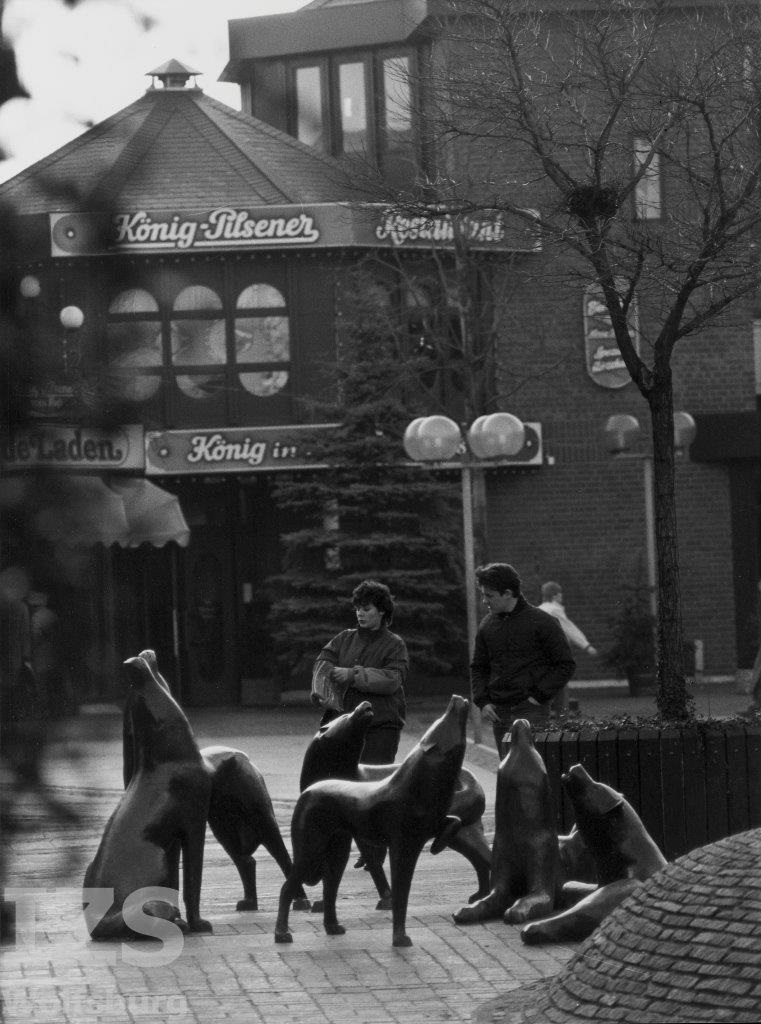Wolf Group, Peter Lehmanns (1981)
From Maik Ullmann
When the city decided to transform its main street into a pedestrian zone in the 1970s,-__-0000-__- art in particular was to make a decisive contribution to the hoped-for quality of the cityscape. The artists' collective Schloßstraße 8 was to support the city as an advisory body for the implementation of the artistic plans. According to a brief description of the artists, "active art" was to be shown, which was to be playable, comprehensible and stimulating at the same time. The green consultation and planning office initiated by the administration, a specialist committee for color design and one for special consultations and advertising matters were to take the lead.
The planned measures were clearly a prestige project for the city of Wolfsburg: the former main artery of the city was not only to be given a new function, but also aesthetically enhanced. To this end, a sculpture was to be purchased that would symbolize Wolfsburg's identity: "The art object should represent something specific to Wolfsburg," as the municipal building department put it." -__-0002-__- As part of the redesign measures - in addition to their advisory work, the artists of Schloßstraße 8 were also invited to participate -__-0003-__- - the administration had already realized Rolf Hartmann's tubular fountain ( --> Hartmann, Röhrenbrunnen) in front of the town hall gates and Jochen Kramer's playground sculpture ( --> Kramer, Spielplatzplastik), although the latter was placed somewhat apart from the Schillerteich.
Large retail chains such as Hertie and the Haerder City Center bordered the northern and southern ends of the pedestrian zone at the time, when the city administration proposed a redesign including artistic design of the central area. A "wolf group" was to be installed for this, as a kind of reification of the city's name. Jochen Kramer, whose 75-centimetre-high, award-winning bronze wolf had already adorned the municipal civic hall since 1959 - the sculpture was the first to be awarded the municipal art prize Junge stadt sieht junge kunst - and the Bremen sculptor Peter Lehmann were asked to submit designs. In the culture committee, the majority voted for Lehmann's design,-__-0004-__- which was realized in November 1981 as a donation from the Sparkasse (Fig. 1).-__-0005-__-

The idea of the artist, who works in Bissel, Lower Saxony, was to produce a six-headed group of animals in cast bronze. The wolves, weighing a total of 590 kilograms, were cast in individual parts and then welded together in a final work step. In their final treatment, the wolf figures were given a color tint instead of a natural patina. Arranged in a circle, they were firmly anchored to the ground in front of the pedestrian zone's "waterscape" using bolts: lying, sitting and standing on all fours, the animals have been howling in chorus towards the Wolfsburg sky for 40 years now. -__-0000-__- A comparable work by Lehmann can be seen in Bremen's Sögestraße. A few years earlier, the artist created the sculpture Schweinehirt und seine Herde (Pig Herder and his Herd ) there, also as a bronze cast .
Lehmann's fascination with the predators created for Wolfsburg goes back to a frontline experience during the Second World War, as he told the local authority in a letter:
"Ever since I once had the opportunity to observe the howling concert for gathering a small pack of wolves on lonely outposts in Russia; - it was not a frontline activity there, but an observation post in case the Russians would seek frontline contact there - , I was fascinated by this interplay and also the highly interesting harmony of the voices. -__-0001-__- From this experience, which never left me, I have had a group of four singing wolves in my head ever since, of which I have only ever been able to attach individual poses in the form of dogs. This would be the opportunity for a wolf chorus." -__-0002-__- (Fig. 2)

The fact that Lehmann's inspiration for the design of a pack of wolves came from his time serving in the Wehrmacht apparently did not bother anyone at the time. However, the pack's imagery was used in the media. The editors of the Wolfsburger Nachrichten commented on the installation of the sculpture at the time via the "Isegrimm", a wolf figure borrowed from medieval legends, who used satirical texts to point out supposed grievances in the city: "But look, on closer inspection, that all the bronze Isegrimm / raise their voices howling / Not one is silent, I wonder why?" -__-0000-__- The "Isegrimm" interpreted the howling of the wolves as an accusation against the "howling bad-__-0001-__-" times, apparently referring to the austerity measures being pursued by the city. These measures were due to the ongoing nationwide financial and economic crisis, which weakened all sectors at the time. It is therefore hardly surprising that the wolf pack (Fig. 3), which was initiated back in 1979, was received at the time as an expression of precisely these times of upheaval. The administration wanted to set an example for the city and the population - however, such a reaction was probably not what those responsible had in mind when they said they wanted to create "something specific for Wolfsburg". But doesn't the question of identity arise particularly often in times of crisis?

Sources
-__-0000-__- StadtA WOB, HA 9299, letter from the Education and Culture Office to the artists' group "Schloßsstraße 8" dated September 24, 1975.
-__-0001-__- StadtA WOB, HA 18145, City of Wolfsburg to all Schloßkünstler of Schloßstr. 8 dated April 27, 1977.
-__-0002-__- IZS Wolfsburg, Az. 65 15 02 7, Kunst im Stadtbild, Ausgestaltung des Fußgängerbereiches Porschestraße-Mitte mit einer Tierplastik, Hochamt Stadt Wolfsburg an den Kulturausschuss, Bauausschuss, Finanzausschuss, Verwaltungsausschuss vom 8. August 1979.
-__-0003-__- StadtA WOB, HA 18145, excerpt from the minutes of the 6th meeting of the Culture Committee on June 1, 1977.
-__-0004-__- IZS Wolfsburg, Az. 65 15 02 7, Kunst im Stadtbild, Ausgestaltung des Fußgängerbereiches Porschestraße-Mitte mit einer Tierplastik, Hochamt Stadt Wolfsburg an den Kulturausschuss, Bauausschuss, Finanzausschuss, Verwaltungsausschuss vom 8. August 1979.
-__-0005-__- IZS Wolfsburg, ref. 65 15 02 7, Art in the cityscape, "Animal group" project, memo concerning art in the cityscape dated February 7, 1979.
-__-0006-__- In the 2000s, the sculpture was moved a few meters.
-__-0007-__- StadtA WOB, HA 17533, Peter Lehmann to the City of Wolfsburg dated March 30, 1979.
-__-0008-__- Here and in the following "Howling wolves in the foot zone", in: Wolfsburger Nachrichten of November 17, 1981.